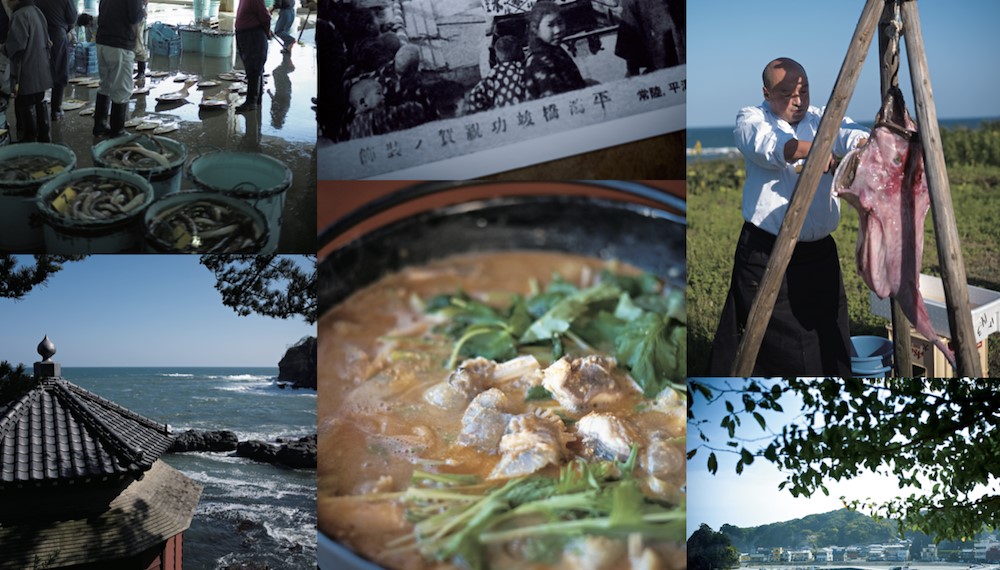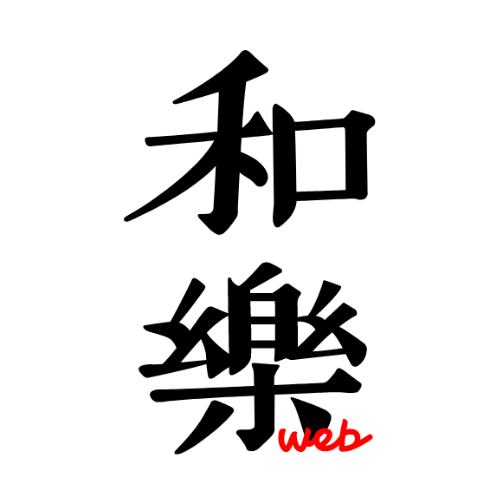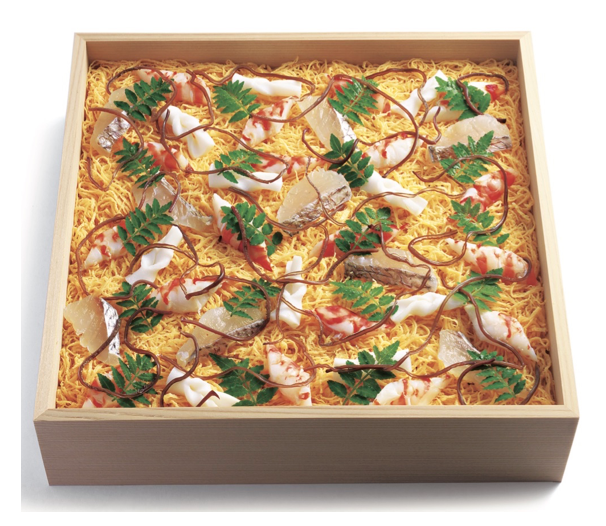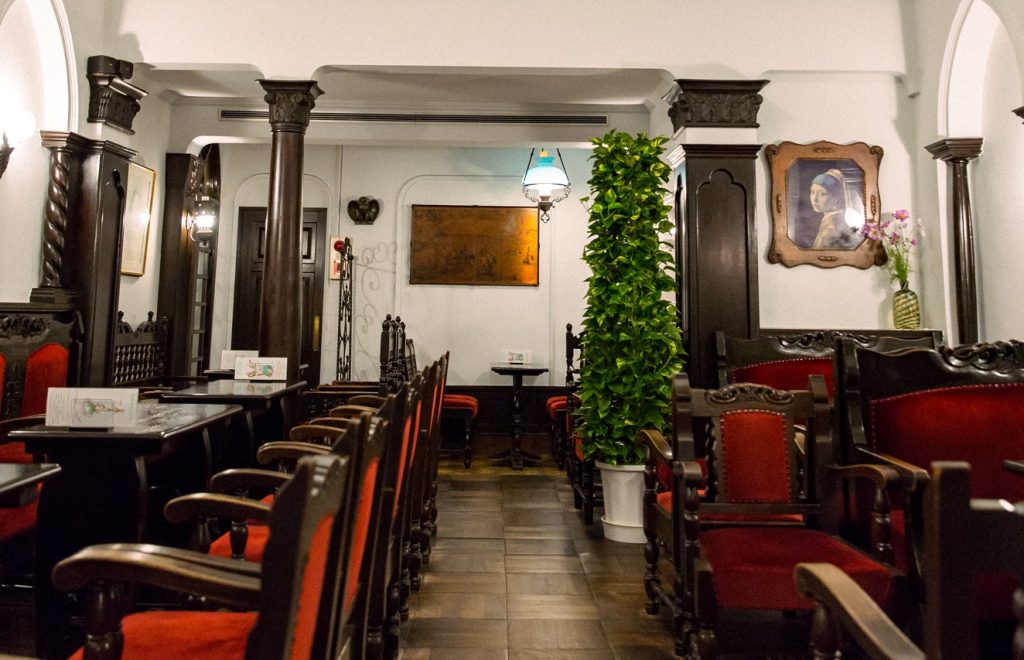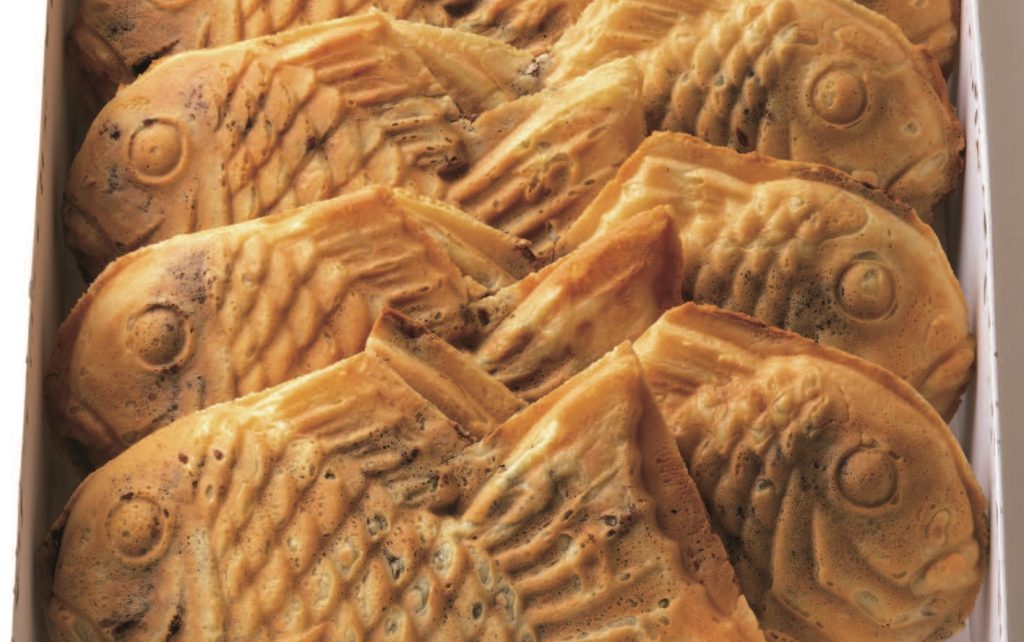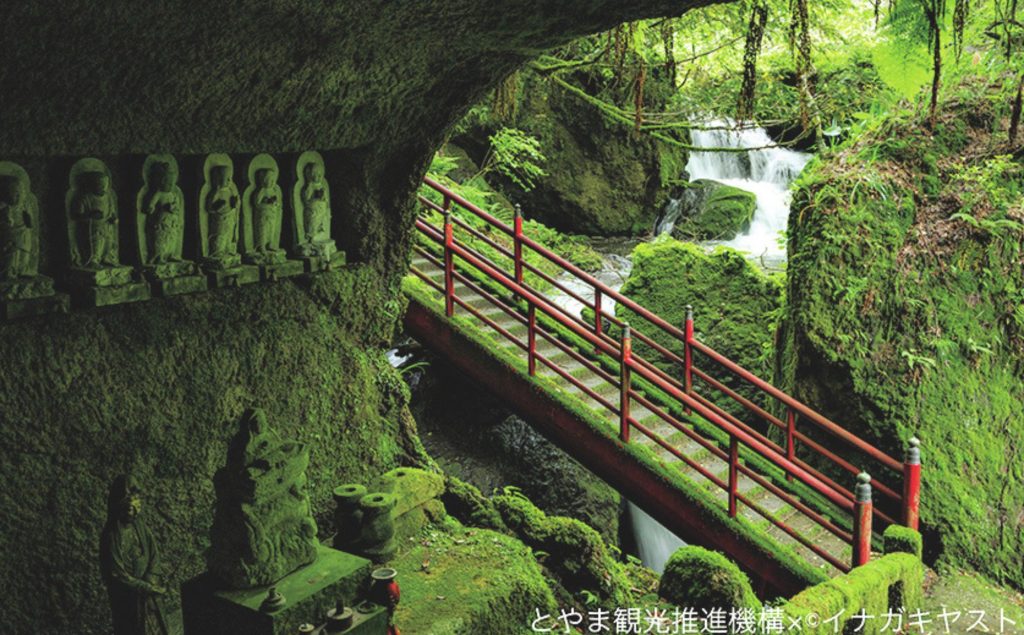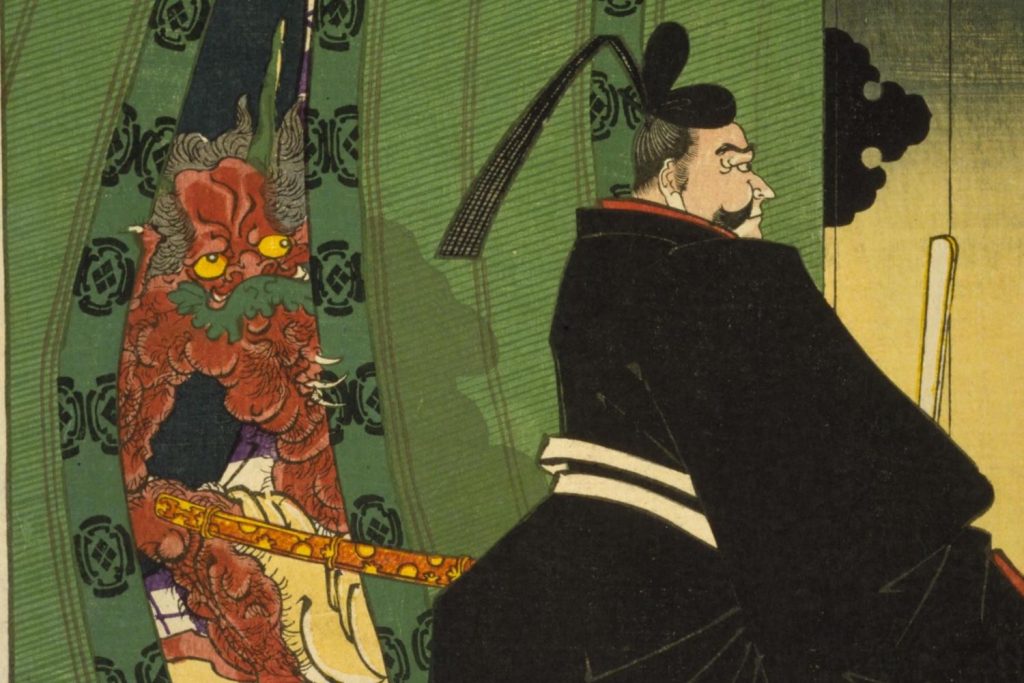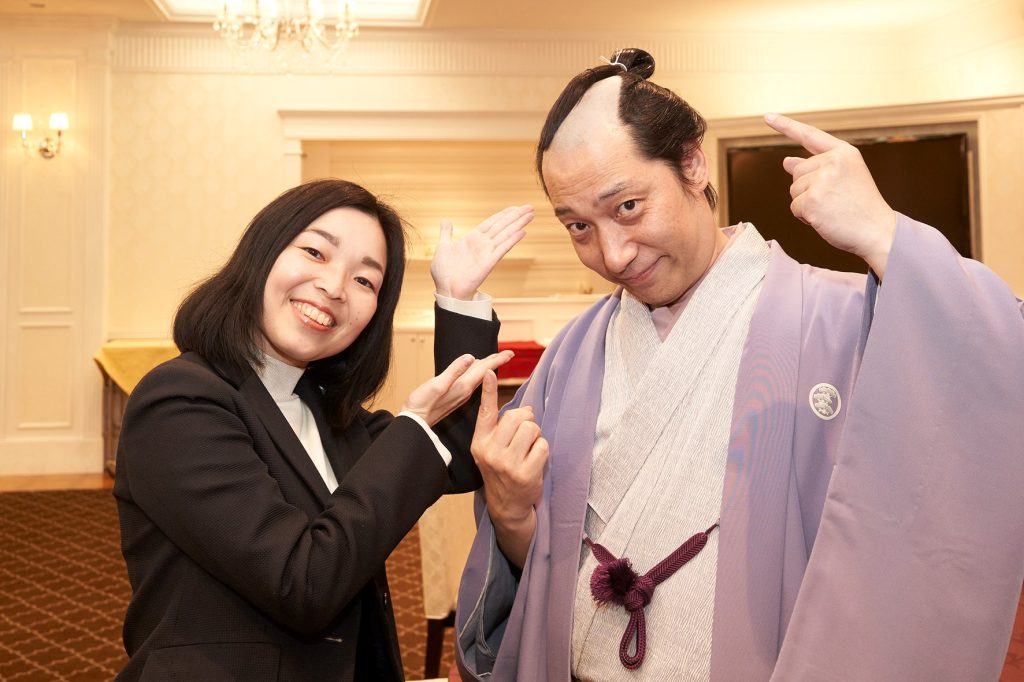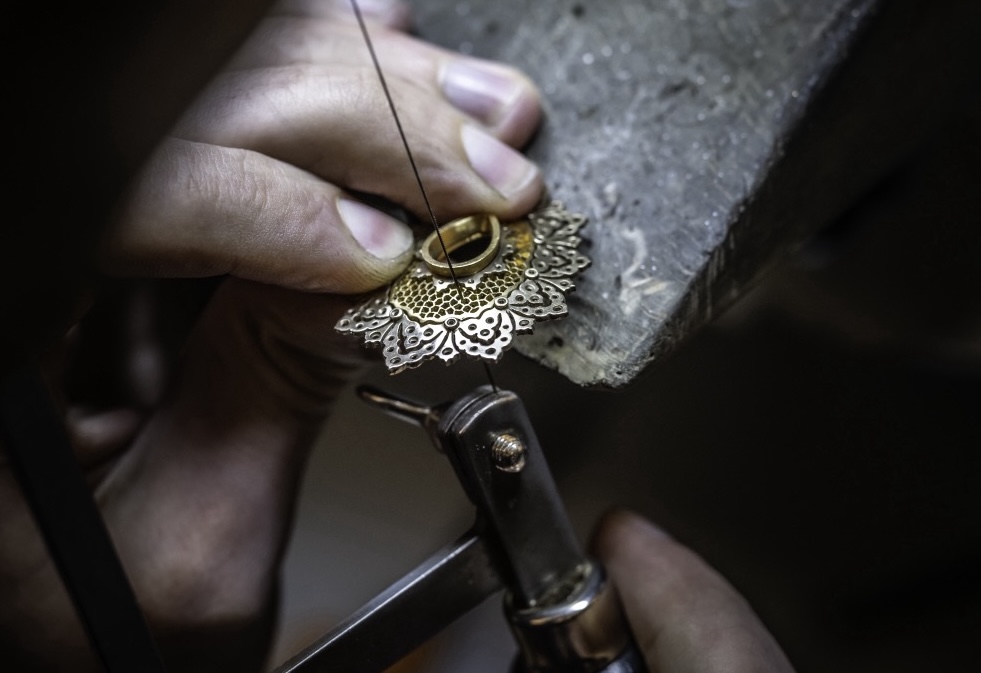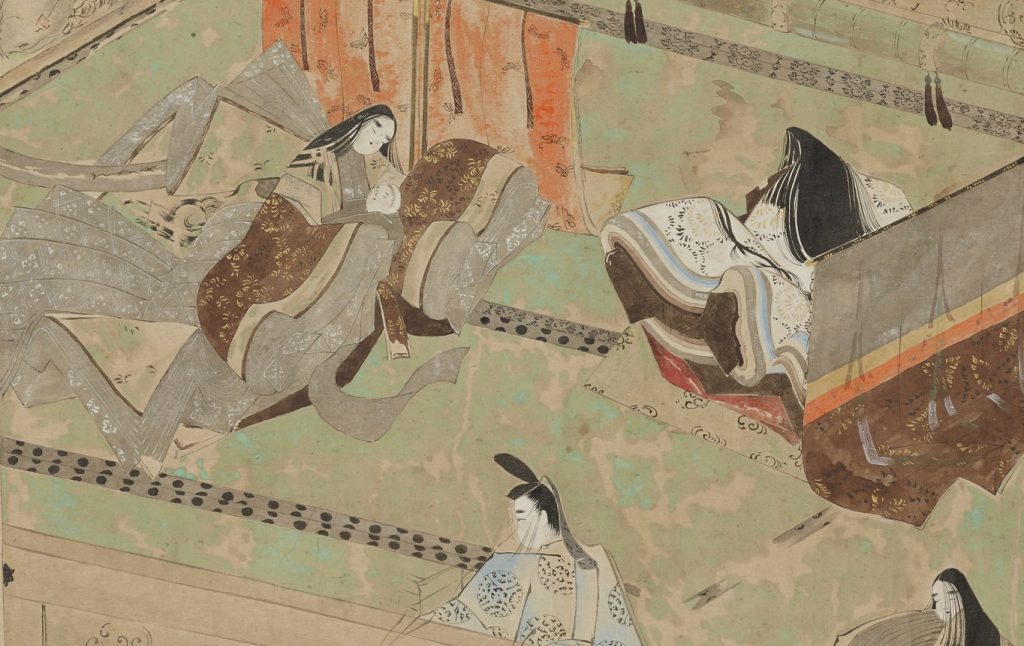Monkfish, a representative of winter delicacies and the king of Hot pot dishes, is a fish that can be eaten not only with its meat but also with everything except the bones, including the skin and entrails, as praised by Kitaoji Rosanjin (北大路魯山人), a well-known food connoisseur. Since monkfish is large and slimy, there is a traditional and unique way of handling it called ‘Tsurushi-giri (吊るし切り)’ instead of using a cutting board.
In my search for the best Monkfish Hot pot, I came across ‘dobu-jiru (どぶ汁)’, which is said to have its roots in monkfish. It originated in Hirakata (平潟), a town in the northern part of Ibaraki Prefecture, the home of monkfish. This dense Hot pot, which is said to have been eaten by fishermen in Kitaibaraki, is filled with the love and ingenuity of people who live by the sea.
Monkfish hot pot originates from a Hirakata fisherman’s dish
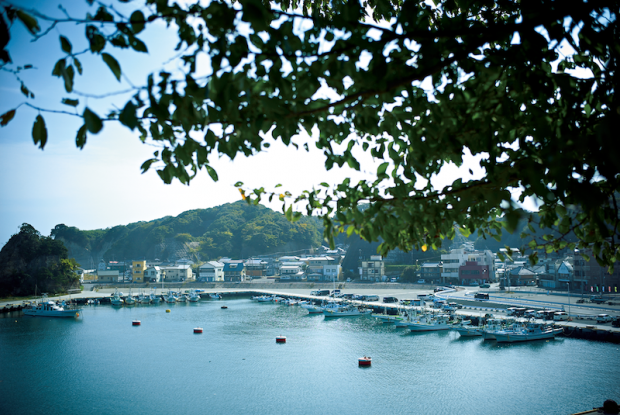
Although monkfish are known as the ‘Higashi no Yokozuna (東の横綱)’, they actually range from Hokkaido to Kyushu, with Yamaguchi, Shimane, Aomori, and Ibaraki prefectures being the most famous recent production areas. Among them, Hirakata is one of the leading anko landing sites in Ibaraki Prefecture. The waters between Ibaraki and Fukushima Prefectures, where the Oyashio (親潮) and Kuroshio (黒潮) currents meet, are rich in fishing grounds, and the ‘Joban-mono (常磐もの)’ Kianko caught in these waters are highly sought after as the best of the best.
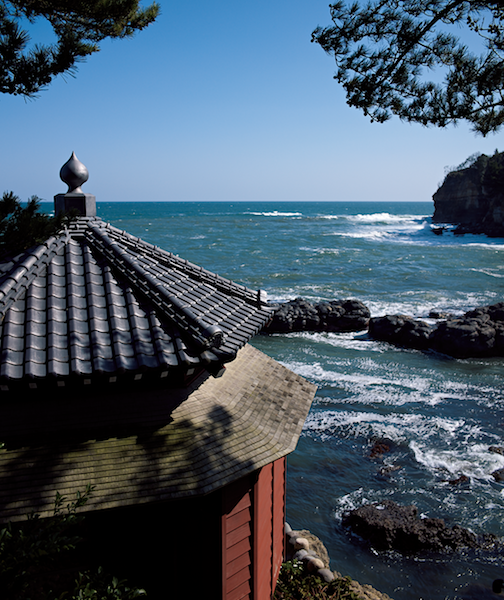 ©︎ Ibaraki University’s Izura Institute of Art and Culture
©︎ Ibaraki University’s Izura Institute of Art and Culture
Izura Rokkakudo (727-2 Izura, Otsu-cho, Kitaibaraki City, Ibaraki Prefecture), where Okakura Tenshin indulged his contemplation.
Hirakata is also the birthplace of ‘Dobu-jiru (どぶ汁)’, which monkfish hotpot is said to have originated from. This port town, which nurtured such dubu-jiru, is also close to the Izura Coast, where Okakura Tenshin (岡倉天心) loved and spent his later years. Tenshin was fascinated by the scenery of five coves of various sizes eroded by the Pacific Ocean, with sheer cliffs, and by the fishing he enjoyed here. The Hirakata Fishing Port, a five-minute drive from the Itoura Coast, is also a beautiful harbor built on a natural inlet.
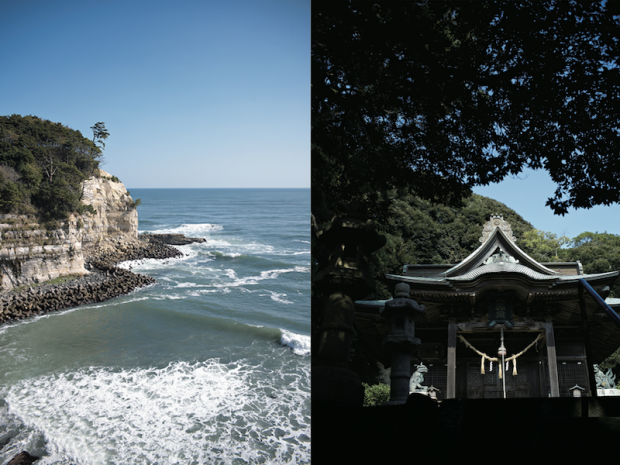 Left/The beauty of the coastline is breathtaking. Right/’Hachiman Jinjya (八幡神社)’ (667 Daiho, Shimotsuma City, Ibaraki Prefecture, official website), built as a Shinto shrine for Hirakata.
Left/The beauty of the coastline is breathtaking. Right/’Hachiman Jinjya (八幡神社)’ (667 Daiho, Shimotsuma City, Ibaraki Prefecture, official website), built as a Shinto shrine for Hirakata.
Hachiman Jinjya was built on a hill to watch over the small port during the Edo period. The small town, now with a population of about 2,000, prospered during the Edo period when it became a port of call for eastbound shipping between the Tohoku region and Edo (present-day Tokyo), and a camp for the Sendai clan was established there.
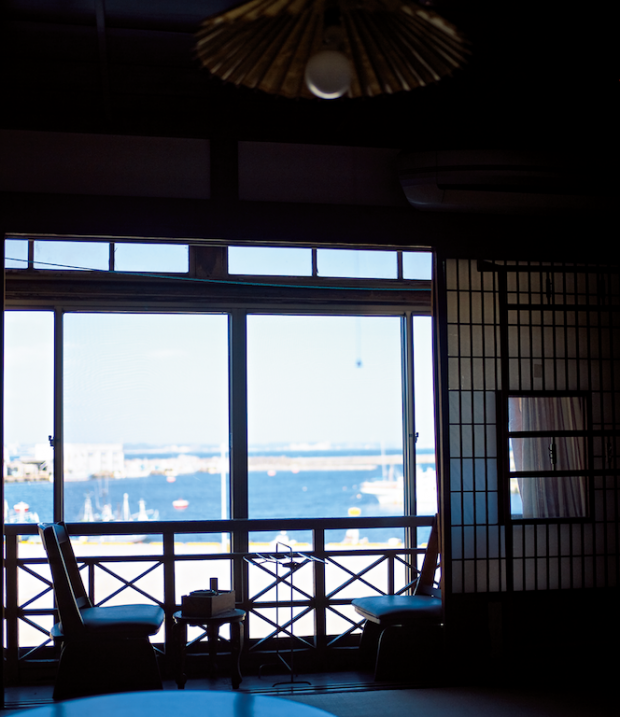 The view of the harbor spreads out through the window of the room at ‘Tokamiya Ryokan (砥上屋旅館)’ (1630 Isohara Isohara-cho, Kitaibaraki City, Ibaraki Prefecture, official website).
The view of the harbor spreads out through the window of the room at ‘Tokamiya Ryokan (砥上屋旅館)’ (1630 Isohara Isohara-cho, Kitaibaraki City, Ibaraki Prefecture, official website).
The history of Hirakata can be seen in the impressive wooden structure of the Tokamiya Ryokan, which was founded in the Meiji Era. Marumitsu Ryokan, located on a slope extending from the harbor, was a key player in making Hirakata famous as a ‘town of monkfish’. In the 1950s, only the meat of monkfish was sold and the rest was thrown away. The owner of the inn at that time, Takeshi Mitsuo (武子光男), focused his attention on the dubu-jiru, which the fishermen used to eat, and served it to the guests of the inn, where it was a big hit. This was the beginning of the spread of dubu-jiru in Hirakata.
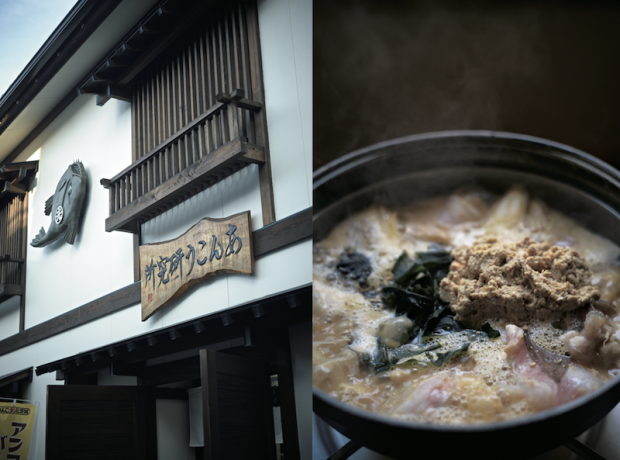 Dobu-jiru at Marumitsu Ryokan (235 Hirakata-cho, Kitaibaraki City, Ibaraki Prefecture, official website), which operates the Anko Laboratory, is also excellent.
Dobu-jiru at Marumitsu Ryokan (235 Hirakata-cho, Kitaibaraki City, Ibaraki Prefecture, official website), which operates the Anko Laboratory, is also excellent.
There are now about 20 inns and minshuku (民宿) in this town where dubu-jiru and monkfish Hot pot are available. Some inns will accommodate only lunch if reservations permit. You can also enjoy monkfish Hot pot at ‘Morimoa’ (143 Hirakata-cho, Kitaibaraki City, Ibaraki Prefecture), a seaside coffee shop where you can spend time while watching the fishing boats docked in the harbor.
What is ‘Dobu-jiru’ loved by the fishermen of Hirakata?
Dobu-jiru is a soup that has been loved by fishermen and people living on the beaches of this well-known monkfish production area since ancient times. Dobu-jiru is different from monkfish Hot pot, in which the meat and liver are simmered in a familiar soysauce based broth.
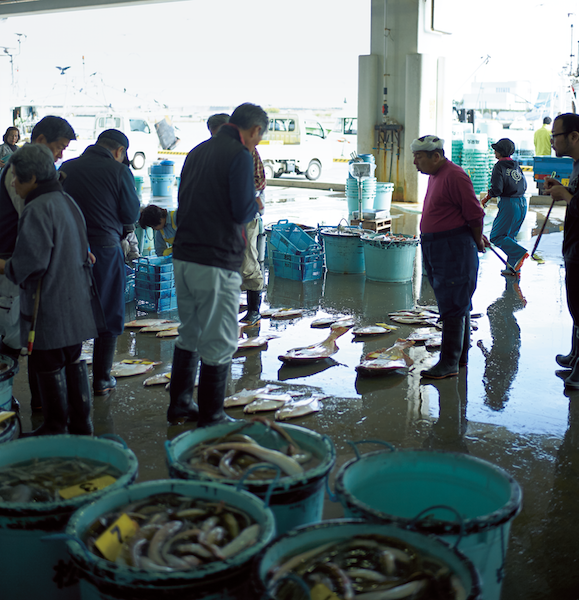 At the Hirakata fishing port in Ibaraki Prefecture. Hirame, Karei, and monkfish…the fish that have been landed are lined up in rows, and the auction begins.
At the Hirakata fishing port in Ibaraki Prefecture. Hirame, Karei, and monkfish…the fish that have been landed are lined up in rows, and the auction begins.
Until around the 1950s, monkfish were laid out all over the beach in this area in the winter”, says Mr. Takeshi Naoyuki of the Hirakata Fishing Cooperative. In a town where such a scene was a winter tradition, dobu-jiru, which was originally eaten by local fishermen on board their boats to warm their cold winter bodies from the inside out, has taken root as an monkfish dish unique to this area.
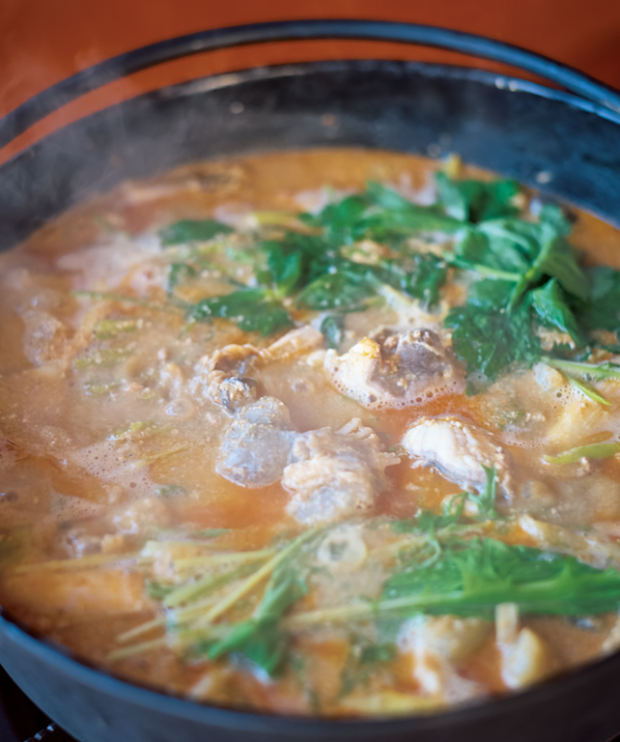 Dobu-jiru at ‘Akatsukien (暁園)’ in Hirakata. The key to its deliciousness is the orange-colored soup in which the monkfish liver is dissolved.
Dobu-jiru at ‘Akatsukien (暁園)’ in Hirakata. The key to its deliciousness is the orange-colored soup in which the monkfish liver is dissolved.
The process is as simple as roasting the plump, fat monkfish’s gall, adding miso, and simmering the water from the meat with a few vegetables such as monkfish and daikon radish. This simple, yet delicious-looking nabe is made using all of the anglerfish’s ‘seven tools’, including the meat, skin, liver, fins, gills, ovaries, stomach, and all but the bones, The wisdom of using only the water from the monkfish and conserving the limited resources of water on the boat is also utilized in this dish.
Monkfish every part of the monkfish is edible. Delving into the secrets behind the rich broth.
As dobu-jiru spread from the boats to the people on the beach and then to local inns and hotels, various innovations were made to make it easier to make and eat. Nowadays, generally called “dobu-jiru”, a nabe that uses a lot of monkfish liver, including those with secret broth or water added, and in which the liver is dissolved and the soup becomes muddy.
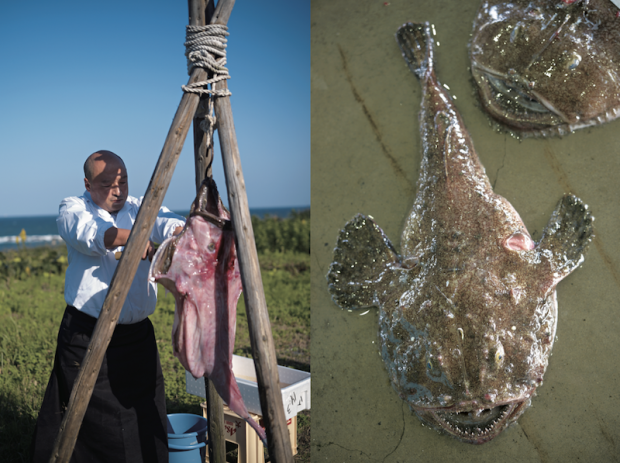 The traditional method of handling monkfish, which is 80% watery and slimy, is called ‘Tsurushi-giri (吊るし切り)’. Now that the cooking environment has been improved, monkfish is often handled with a knife. At Akatsukien, guests can see the hanging process when they request it.
The traditional method of handling monkfish, which is 80% watery and slimy, is called ‘Tsurushi-giri (吊るし切り)’. Now that the cooking environment has been improved, monkfish is often handled with a knife. At Akatsukien, guests can see the hanging process when they request it.
Niida Yasumasa (仁井田康昌), the owner of “Akatsukien,” a guest house overlooking the Pacific Ocean in Hirakata, who made the nabe for us, uses no water at all and adds the anko as is, in a way that is close to his original recipe. The anko of the day was a large fish weighing about 15 kg, landed at Hirakata Fishing Port.
This time, the anko was specially cut in the traditional way of Tsurishi-giri. “Nowadays, monkfishare often processed on a cutting board, but the big ones are Tsurishi-giri”, says Mr. Niida. He uses a knife to cut and remove the fins, makes a cut around the mouth, and scrapes off the skin in one go. It takes about five minutes to remove the seven tools. I was surprised at how audacious and dexterous he was. “When I was a child, we had monkfish every day in winter. Dobu-jiru was a substitute for miso soup”. “The amount of water content differs from monkfish, so the time it takes to roast the liver and the amount of miso to add differ.”
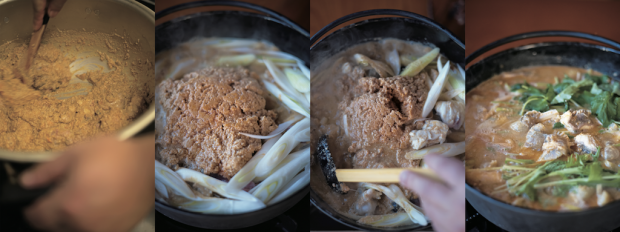 Dobu-jiru is characterized by its surprisingly lavish use of ankimo. Originally, each pot of dobu-jiru was made by roasting ankimo, but in order to stabilize the flavor, the “Akatsukien” style is to roast all the monkfish liver together.
Dobu-jiru is characterized by its surprisingly lavish use of ankimo. Originally, each pot of dobu-jiru was made by roasting ankimo, but in order to stabilize the flavor, the “Akatsukien” style is to roast all the monkfish liver together.
The key to this Hot pot is the generous and generous use of monkfish liver, the ‘Umi no Foagura (海のフォワグラ)’. When the pot, which contains only monkfish, daikon radish, green onions, and miso paste, begins to simmer, the water that naturally comes out of the monkfish turns into juice, and the oil from the liver turns it a cloudy orange color. When served hot, the soup is rich and thick. The meat is fluffy, and the plumpness of the meat is very nice. The real pleasure comes from being able to enjoy the different textures of the various parts of the fish, from the fluffy meat to the plump skin, from the sticky to the soft and juicy. Some people like the meat, some like the skin, and it is impossible to decide which is the best. You can eat every part, and every part will be delicious. The Hot pot, which makes the most of the fish’s flavor, is superb all the way through to the rice porridge at the end of the meal!
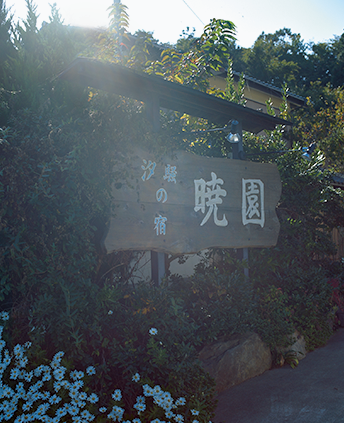
◆Shiosai no Yado Akatsukien
Address: 1519-23 Hirakata-cho, Kitaibaraki City, Ibaraki Prefecture (map)
tel 0293-46-5891
12:00-14:00, 18:00-20:30 Open all year round. 3,800 yen per person for dobu-jiru (tax included). Dobu-jiru is available only from October to the end of April. Reservations are required by the day before (minimum of 2 people). Lodging is also available.
People living peacefully in a scenic port town
The auction at Hirakata Fishing Port starts at 12:00 pm. In preparation for the auction, trawlers and other vessels that set out late at night return one after another. However, one day in October 2018, when we visited the port for our report, the sea was choppy due to a typhoon that hit far away, delaying the return of the boats, and the auction began after 2:00 p.m. Only three Hot pot that day. The harshness of the sea was not the only reason. This town, located on the border with Fukushima Prefecture, was severely damaged by the tsunami that followed the Great East Japan Earthquake. Even so, people continue to live peacefully, rooted in their hometown and accepting the blessings and threats of the sea.
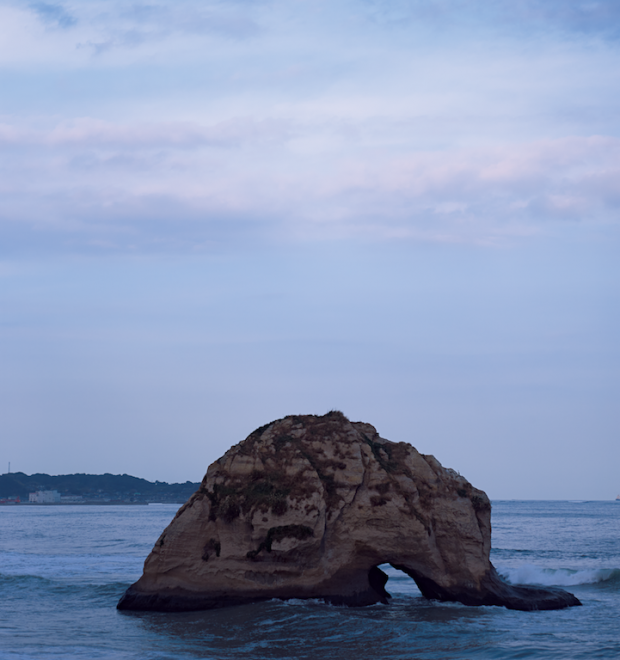 Futatsushima (二ツ島), a symbol of Kitaibaraki with two islands, one large and one small. The islands were affected by the Great East Japan Earthquake and are now shaped like elephants.
Futatsushima (二ツ島), a symbol of Kitaibaraki with two islands, one large and one small. The islands were affected by the Great East Japan Earthquake and are now shaped like elephants.
Monkfish hotpot season in Hiragata starts in October and is said to be at its best from December to February, when the weather turns colder and the liver fattens. This makes me want to visit Hirakata again in mid-winter to enjoy the idyllic time that passes in this picturesque port town, along with the excellent dobu-jiru.
This article is translated from https://intojapanwaraku.com/rock/gourmet-rock/2319/






